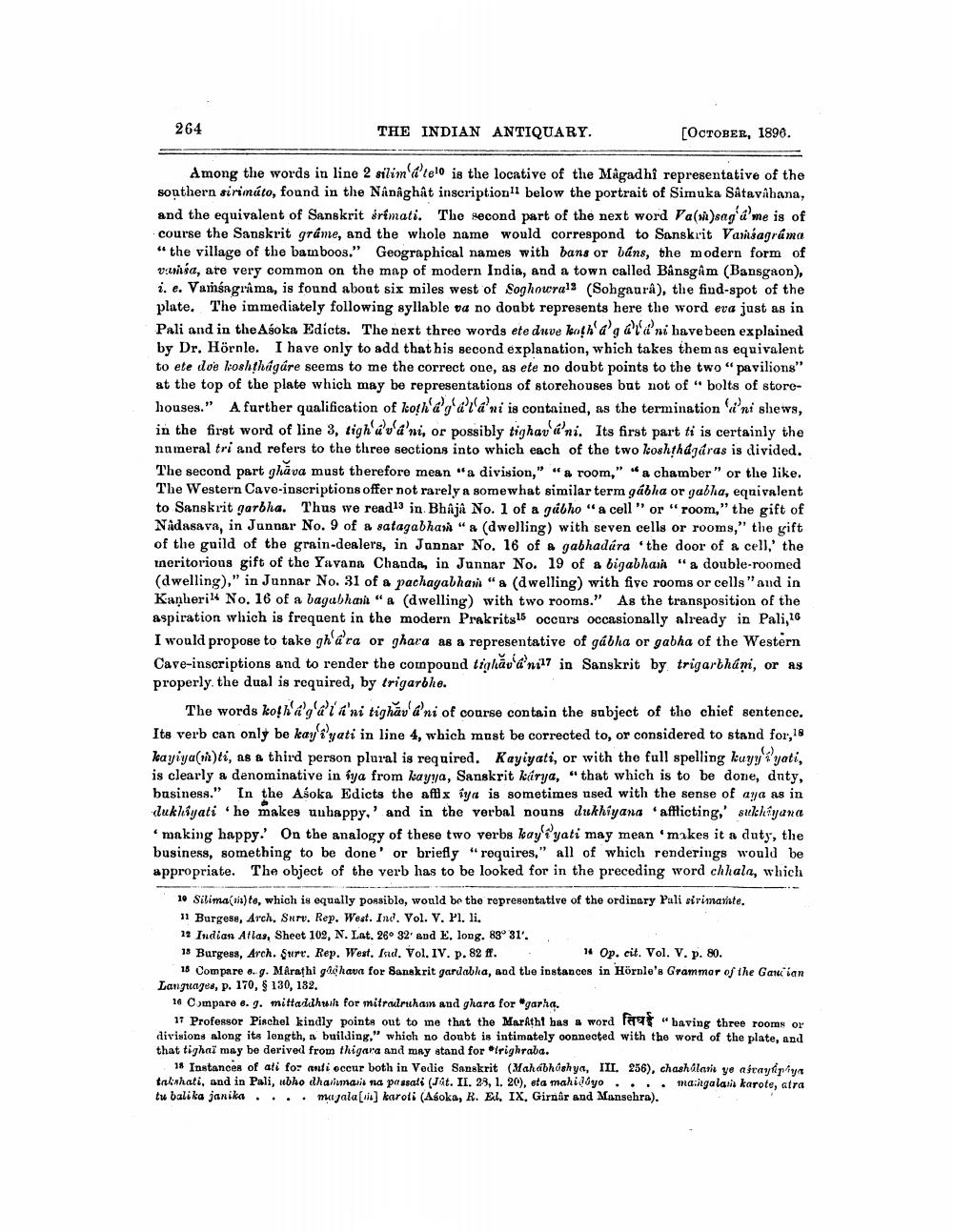________________
264
THE INDIAN ANTIQUARY.
[OCTOBER, 1898.
Among the words in line 2 silim a telo is the locative of the Magadhi representative of the southern sirimáto, found in the Nânâghât inscription" below the portrait of Simuka Såtavibana, and the equivalent of Sanskrit Srimati. The second part of the next word Vasag 'me is of course the Sanskrit gráme, and the whole name would correspond to Sanskrit Variagrama "the village of the bamboos." Geographical names with bans or láns, the modern form of varsa, are very common on the map of modern India, and a town called Bansgâm (Bansgaon), i. e. Vamśagrama, is found about six miles west of Soghoura13 (Sohgaura), the find-spot of the plate. The immediately following syllable ua no doubt represents here the word eva just as in Pali and in the Asoka Edicts. The next three words ete duve leoth a'g & t&'ni have been explained by Dr. Hörnle. I have only to add that his second explanation, which takes them as equivalent to ete dve loshthágáre seems to me the correct one, as ete no doubt points to the two "pavilions" at the top of the plate which may be representations of storehouses but not of "bolts of storehouses." A further qualification of kotha g'ara'ni is contained, as the termination ini shews, in the first word of line 3, tigh a'uld'ni, or possibly tighav &'ni. Its first part ti is certainly the nameral tri and refers to the three sections into which each of the two koshtházáras is divided. The second part ghăva must therefore mean "a division," "a room," "a chamber" or the like. The Western Cave-inscriptions offer not rarely a somewhat similar term gábla or gabha, equivalent to Sanskrit garbha. Thus we read13 in BhAjà No. 1 of a gábho "a cell" or "room," the gift of Nadasava, in Junnar No. 9 of a satagabhas "a (dwelling) with seven cells or rooms," the gift of the guild of the grain-dealers, in Jannar No. 16 of a gabhadára the door of a cell,' the meritorious gift of the Yavana Chanda, in Junnar No. 19 of a bigabhair "a double-roomed (dwelling)," in Junnar No. 31 of a pachagabhani "a (dwelling) with five rooms or cells" and in Kanheril4 No. 16 of a bagubhai "a (dwelling) with two rooms.” As the transposition of the aspiration which is frequent in the modern Prakrits15 occurs occasionally already in Palio I would propose to take gha'ra or ghara as a representative of gábha or gabha of the Western Cave-inscriptions and to render the compound tighăv'á'na17 in Sanskrit by trigarbhán, or as properly, the dual is required, by trigarbhe.
The words kohag'd'la'ni tighăva'ni of course contain the subject of the chief sentence. Its verb can only be kayfiyati in line 4, which must be corrected to, or considered to stand for, 18 kayiya(n)ti, as a third person plural is required. Rayiyati, or with the full spelling kuyyyati, is clearly a denominative in fya from kayya, Sanskrit karya, “that which is to be done, dnty, business." In the Asoka Edicts the afts iya is sometimes used with the sense of aya as in lukhiyati he makes uuhappy,' and in the verbal nouns dukhiyana afflicting,' suchiyana
making happy. On the analogy of these two verbs kayiyati may mean makes it a duty, the business, something to be done' or briefly "requires," all of which renderings would be appropriate. The object of the verb has to be looked for in the preceding word chhala, which
10 Silima(vi)te, which is equally possible, would be the representative of the ordinary Pali sirimate. 11 Burgese, Arch. Sury. Rep. West. Ind. Vol. V. Pl. li. 12 Indian Allas, Sheet 102, N. Lat. 26° 32' and E. long. 83° 31'. 18 Burgeon, Arch. Sure, Rep. West. Isid. Vol. IV. p. 82 ff. .
Op. cit. Vol. V. p. 80. 18 Compare e. g. Marathi gabhava for Sanskrit gardabha, and the instances in Hörnle's Grammar of the Ganian Languages, p. 170, $ 130, 182.
16 Comparo o. 9. mittaddhwilt for mitralruhain and ghara for "garha.
11 Professor Pinchel kindly points out to me that the Marathi has a word for "baving three rooms or divisions along its longth, building," which no doubt is intimately connected with the word of the plate, and that tighai may be derived from thigara and may stand for Irighraba.
15 Instances of all for anti occur both in Vodie Sanskrit (Mahabhdahya, III. 256), chashlari ye afrayriye takshati, and in Pali, ubho ahallasis na passati (Ját. II. 23, 1. 20), sta mahidyo.... maigalai karote, atra tu balika janika.... mayalan] karoti (Asoka, R. Eil, IX, Girnar and Mansehra).




